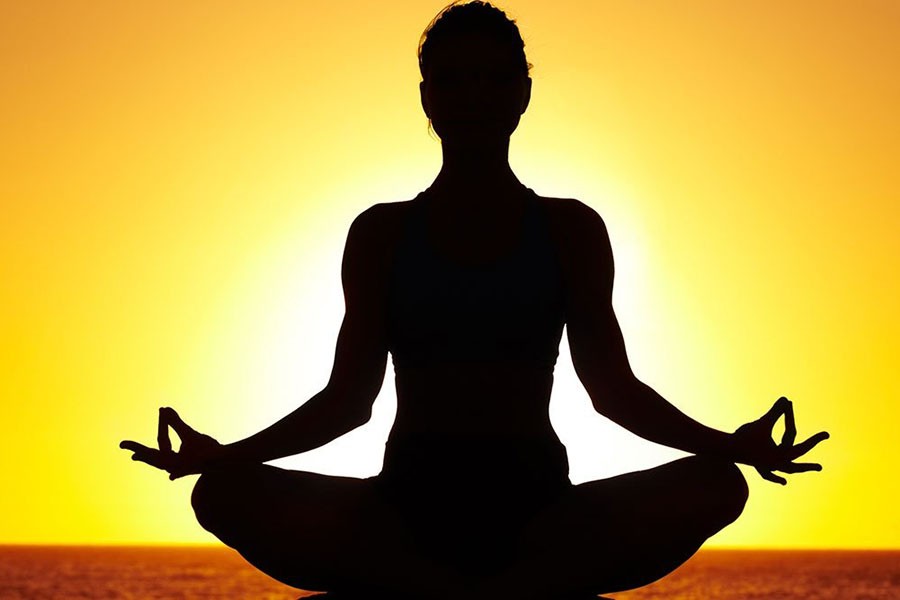The fourth International Day of Yoga was observed across the globe including Bangladesh on June 21with the slogan 'Yoga for Peace'. Earlier, the India-sponsored resolution for observing the day was unanimously adopted by the UN General Assembly in December 2014, with the broad support and backing from a record 177 co-sponsoring states. The longest day of the year in the northern hemisphere - June 21 was chosen for the occasion, as the day has special significance for people in many corners of the globe.
Historians claim Yoga was developed during the era of Indus-Saraswati Valley Civilization in northern India over 5,000 years ago. It is basically a physical-cum-spiritual discipline focused on bringing harmony between the body and mind, and is considered to be both an art and science for healthy living. The Sanskrit word 'Yoga' means 'to join' or 'to unite'. The practice of Yoga is aimed at unifying individual consciousness with that of the universal, thereby attaining perfect harmony between body and mind, man and Nature. One who can experience this oneness of existence is deemed to be a yogi, whose ultimate aim is to achieve 'Nirvana', 'Moksha' or spiritual salvation.
Yoga is one of the six systems of Hindu theistic philosophy founded on the Vedas. These systems are collectively known as 'Sada Darshan'. The other five systems are: Samkhya, Nyaya, Vaishesika, Mimamsa and Vedanta. On the other hand, the Charvaka, Buddhist and Jain philosophies are considered to be atheistic, as they do not believe in the Vedas. Belief in God, however, is not a determining factor in this classification.
The Yoga philosophy was introduced by the ancient sage Patanjali during the 2nd century BC through his Yoga Sutras. He wrote as many as four books on the subject. The first book discussed the attributes of Yoga and meditation. The second dwelt on themes like 'Yama', which must be followed before applying the deeper spiritual techniques as well as various Asanas or postures. The third book discussed perception, meditation, concentration as well as their outcomes and relevance to man's well-being. The fourth book discussed the five types of attainments and the ultimate necessity for liberation or salvation of the spirit.
According to this philosophy, Yoga comprises an eight-fold path. These are: Yama or self-discipline; Niyama or the rules; Asana or the Yogic postures; Pranayama or regulated breath; Pratyahara or sense detachment; Dharana or inner abstraction; Dhyana or meditation; and Samadhi or the state of bliss.
Yoga Shastra classified Yoga into four broad categories. These are: Bhakti (devotion); Karma (action); Jnana (knowledge); and Hatha (force). The latter is practised most widely and adheres to a system of physical exercises for attaining perfection in body and mind. The Bhagavad Gita also refers to other methods of Yoga like Kundalini (spinal base), Dhyana (meditation) and Raja (kingly). The Yoga system has been described by the Bhagavad Gita as an effective tool for controlling the body and mind.
Yoga started travelling to the West in the late 19th century. The first of the masters was Swami Vivekananda who captivated the American audience during a lecture on Yoga in Chicago during 1897. Swami Vivekananda founded a global organisation called Ramakrishna Mission (named after his master), which works for keeping the spiritual traditions of India alive and thereby uplifts society. In the modern era, Yoga has spread across the globe through the teachings of great personalities like Swami Shivananda, Shri Krishnamacharya, Shri Aurobinda, Maharshi Mahesh Yogi, Acharya Rajanish, BKS Iyengar, Swami Satyananda Sarasvati and Sri Sri Ravi Shankar et al.
Currently, more emphasis is laid on the physical exercises of Yoga around the globe than on its philosophical or spiritual dimensions. Besides, its practitioners tend not to link it with any particular religion like Hinduism. People in many countries of the world practise Yoga to remain physically and mentally fit. In neighbouring India where it is widely practised, the West Bengal Secondary Education Board incorporated Yoga in the school curriculum in 1976. Yoga education is also imparted in India by Yoga institutions, departments in universities, naturopathy colleges, private trusts, foundations and societies. Many Yoga clinics, therapy and training centres, Yoga-based preventive healthcare units, research centres etc. have also been established in hospitals, dispensaries and medical institutions.
On the eve of the International Yoga Day this year, the World Health Organisation (WHO) called for harnessing the full potential of Yoga, as it curtails the risks of life-threatening non-communicable diseases. The world body claimed that practising yoga reduces the risks of non-communicable diseases (NCDs) such as hypertension, stroke, heart attack and diabetes that cause around 8.5 million deaths across the WHO's Southeast Asia region annually.
On the other hand, the UN Deputy Secretary-General Amina Mohammed said during her address marking the fourth anniversary of the day, "Today's world is incredibly complex. We are challenged by an erosion of core values and in many walks of life stress is given, delusion prevails especially amongst our youth…Yoga, deriving from the Sanskrit word 'unity', is so very apt for the United Nations".
In India, Prime Minister Narendra Modi said, "Yoga Day has become the biggest mass movement across the globe in the quest for good health and well-being, which is crucial to the creation of a peaceful world." On the other hand, two prominent Islamic spokespersons of India said on the occasion that people of all religions and sections of society should be encouraged to celebrate Yoga Day; it should be seen as a form of exercise and not viewed through the prism of religion.
Numerous Yoga clubs have also sprouted in Bangladesh during the past few decades, which include the globally reputed 'Art of Living Foundation'. Besides, many urban and rural inhabitants in the country traditionally perform Yoga exercises since long in the privacy of their homes. In this way, the practice of Yoga is still gaining ground in Bangladesh as elsewhere in the world, principally as a regimen of exercises to keep the body and mind healthy, peaceful and harmonious.


